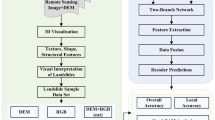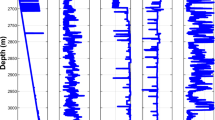Abstract
Filtering is an essential step in the process of obtaining rock data. To the best of our knowledge, there are no special algorithms for use in the point clouds of rock masses. Existing filtering methods remove noisy points by fitting the surface of the ground and deleting the points above the surface around a range of values. This type of methods has certain limitations in rock engineering owing the uniqueness of the particular rockmass being studied. In this paper, a method for filtering the rock points is proposed based on a backpropagation (BP) neural network and principal component analysis (PCA). In the proposed method, a PCA is applied for feature extraction, and for obtaining the dimensional information, which can be used to effectively distinguish the rock and other points at different scales. A BP neural network, which has a strong nonlinear processing capability, is then used to obtain the exact points of rock with the above characteristics. In the present paper, the efficiency of the proposed technique is illustrated by classifying steep rocky slopes as rock and vegetation. A comparison with existing methods indicates the superiority of the proposed method in terms of the point cloud filtering of rock masses.
Similar content being viewed by others
References
Gigli G, Casagli N. Semi-automatic extraction of rock mass structural data from high resolution lidar point clouds. International Journal of Rock Mechanics and Mining Sciences, 2011, 48(2): 187–198
Jaboyedoff M, Oppikofer T, Abellán A, Derron M H, Loye A. Use of LIDAR in landslide investigations: a review. Natural Hazards, 2012, 61(1): 5–28
Heritage G L,Milan D J. Terrestrial Laser Scanning of grain roughness in a gravel-bed river. Geomorphology, 2009, 113(1): 4–11
Zhang K Q, Chen S C, Whitman D, Yan J H, Zhang C C. A progressive morphological filter for removing nonground measurements from airborne LIDAR data. IEEE Transactions on Geoscience and Remote Sensing, 2003, 41(4): 872–882
Vosselman G. Slope based filtering of laser altimetry data. International Archives of Photogrammetry and Remote Sensing, 2000, 33: 935–942
Akel N A, Zilberstein O, Doytsher Y. Automatic DTM extraction from dense raw LIDAR data in urban areas. In: Proceedings of International Federation of Surveyors Working Week. 2003
Axelsson P. DEM generation from laser scanner data using adaptive TIN models. International Archives of Photogrammetry and Remote Sensing, 2000, 33: 111–118
Pingel T J, Clarke K C,McbrideWA. An improved simple morphological filter for the terrain classification of airborne LIDAR data. ISPRS Journal of Photogrammetry and Remote Sensing, 2013, 77(1): 21–30
Zhang J X, Lin X G. Filtering airborne LiDAR data by embedding smoothness-constrained segmentation in progressive TIN densification. ISPRS Journal of Photogrammetry and Remote Sensing, 2013, 81: 44–59
Sui L, Zhang Y B, Zhang S, ChenW. Filtering of airborne LiDAR point cloud data based on progressive TIN. Geomatics and Information Science of Wuhan University, 2011, 36(10): 1159–1163
Zhang Y K, Zhang X P, Zha H B, Zhang J S. A survey of topologically structural representation and computation of 3D point cloud data. Journal of Image and Graphics, 2008, 13(8): 1576–1587
Sithole G, Mapurisa W T. 3D object segmentation of point clouds using profiling techniques. South African Journal of Geomatics, 2012, 1(1): 60–76
Shi R M, Qi X L. Research on mixed indexing model for cloud points. In: Proceedings of IEEE International Geoscience and Remote Sensing Symposium. 2012, 5301–5303
Ma H C, Wang Z Y. Distributed data organization and parallel data retrieval methods for huge laser scanner point clouds. Computers and Geosciences, 2011, 37(2): 193–201
Gong J, Zhu Q, Zhong R F, Zhang Y T, Xie X. An efficient point cloud management method based on a 3D R-tree. Photogrammetric Engineering and Remote Sensing, 2012, 78(4): 373–381
Lichti D D. Spectral filtering and classification of terrestrial laser scanner point clouds. The Photogrammetric Record, 2005, 20(111): 218–240
Franceschi M, Teza G, Preto N, Pesci A, Galgaro A. Discrimination between marls and limestones using intensity data from terrestrial laser scanner. ISPRS Journal of Photogrammetry and Remote Sensing, 2009, 64(6): 522–528
Kaasalainen S, Jaakkola A, Kaasalainen M, Krooks A, Kukko A. Analysis of incidence angle and distance effects on terrestrial laser scanner intensity: search for correction methods. Remote Sensing, 2011, 3(10): 2207–2221
Vandapel N, Huber D F, Kapuria A, Hebert M. Natural terrain classification using 3-D ladar data. In: Proceedings of IEEE International Conference on Robotics and Automation. 2004, 5117–5122
Lalonde J F, Vandapel N, Huber D F, Hebert M. Natural terrain classification using three-dimensional ladar data for ground robot mobility. Journal of Field Robotics, 2006, 23(10): 839–861
Brodu N, Lague D. 3D terrestrial lidar data classification of complex natural scenes using a multi-scale dimensionality criterion: applications in geomorphology. ISPRS Journal of Photogrammetry and Remote Sensing, 2012, 68(1): 121–134
Burrough P A. Fractal dimensions of landscapes and other environmental data. Nature, 1981, 294(5838): 240–242
Wendt H, Abry P, Jaffard S. Bootstrap for empirical multifractal analysis. IEEE Signal Processing Magazine, 2007, 24(4): 38–48
Peng X, Lu J W, Zhang Y, Yan R. Automatic subspace learning via principal coefficients embedding. IEEE Transactions on Cybernetics, 2016, 47(11): 3583–3596
Peng X, Zhang L, Zhang Y, Tan K K. Learning locality-constrained collaborative representation for robust face recognition. Pattern Recognition, 2013, 47(9): 2794–2806
Ding Y Q, Fu Y M, Zhu F, Zan X. Comparison of missing data filling methods in bridge health monitoring system. In: Proceedings of IEEE International Conference on Cognitive Informatics and Cognitive Computing. 2013: 442–445
Moavenian M, Khorrami H. A qualitative comparison of Artificial Neural Networks and Support Vector Machines in ECG arrhythmias classification. Expert Systems with Applications, 2010, 37(4): 3088–3093
Zhong H M, Miao C Y, Shen Z Q, Feng Y H. Comparing the learning effectiveness of BP, ELM, I-ELM, and SVM for corporate credit ratings. Neurocomputing, 2014, 128(5): 285–295
Lato M, Kemeny J, Harrap R M, Bevan G. Rock bench: establishing a common repository and standards for assessing rockmass characteristics using LiDAR and photogrammetry. Computers and Feosciences, 2013, 50(1): 106–114
Acknowledgments
This work was supported by the National Natural Science Foundation of China (Grant No. 61471338), Youth Innovation Promotion Association CAS (2015361), Key Research Program of Frontier Sciences, CAS (QYZDY-SSW-SYS004), Beijing Nova program (Z171100001117048), and President Fund of UCAS.
Author information
Authors and Affiliations
Corresponding author
Additional information
Jun Xiao is now an associate professor in University of Chinese Academy of Sciences, China. He obtained his PhD degree in the Graduate University of the Chinese Academy of Sciences, China in 2008. His research interests include computer graphics, computer vision, image processing and 3D reconstruction.
Sidong Liu received a Master’s degree in computer application technology from University of Chinese Academy of Sciences, China in 2016. He received his Bachelor’s degree in software engineering from Zhejiang University, China in 2011. His research interests include computer graphics, pattern recognition and point cloud processing.
Liang Hu is now a PhD candidate in computer application technology at University of Chinese Academy of Sciences, China. He received the Bachelor’s degree in software engineering from Xidian University, China in 2012. His research interests include computer graphic, point cloud processing and 3D reconstruction.
YingWang is now a professor in University of Chinese Academy of Sciences, China. She received her PhD degree in Beijing Institute of Technology, China in 1996. Her research interests include computer graphics, visualization and computer vision.
Electronic supplementary material
Rights and permissions
About this article
Cite this article
Xiao, J., Liu, S., Hu, L. et al. Filtering method of rock points based on BP neural network and principal component analysis. Front. Comput. Sci. 12, 1149–1159 (2018). https://doi.org/10.1007/s11704-016-6170-6
Received:
Accepted:
Published:
Issue Date:
DOI: https://doi.org/10.1007/s11704-016-6170-6




